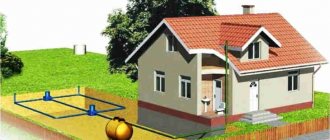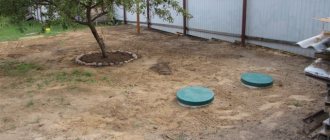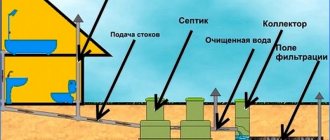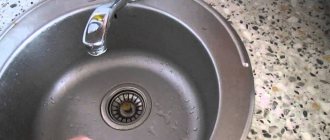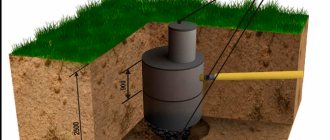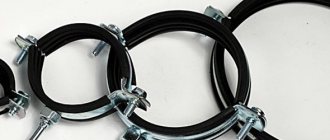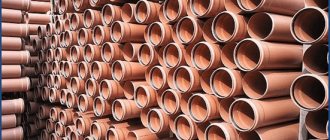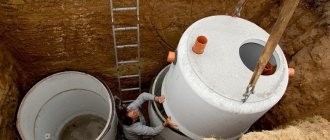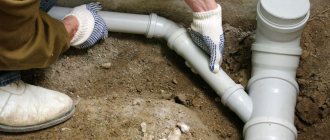Maksym
15266 0 0
Maksym June 16, 2017 Specialization: country construction, apartment renovation, landscaping of a personal plot, installation and connection of utilities.
Use plastic sewer pipes to transport the sink.
Are you planning to renovate your kitchen? Surely you will have to deal with re-equipping or installing a sewer system, because not a single kitchen can do without it. I will try to reveal the main issues related to this topic.
Drainage in the kitchen
Domestic sewerage is quite simple to install and practically does not require design. The essence of installing a sewer system in the kitchen of an apartment or house is the installation of sewer drains that discharge used water into the sewer riser of an apartment or the sewer system of a private house.
Drains are made using sewer pipe bends, at one end of which there is a drain socket, and the other end of the bend goes into the sewer riser.
drainage in the kitchen
The number of sewer drains should be no less than the number of plumbing fixtures in the kitchen. For example, if the only plumbing fixtures in the kitchen are a sink, one drain is enough. If you plan to install a sink, dishwasher and washing machine, then there should be three such drains.
However, it is worth noting that the number of drains should not coincide with the number of sewer outlets. Thanks to the use of sewer fittings (fittings), it is possible to install a tee at the end of one outlet to connect the drains of three or two devices.
Connection diagram
After purchasing a kitchen, there is a need to connect the equipment to utility networks. Typically, kitchen furniture supply companies connect appliances to pre-arranged water and sewerage points, but the problem of laying pipes to these points falls entirely on the shoulders of the customer.
Serious suppliers provide each client with technical documentation for the kitchen, which indicates the coordinates of the connection points for equipment and plumbing fixtures. According to this project, pipe routing is carried out. It must be remembered that all dimensions given in the document are given from the finishing marks of the floor and walls. If you ignore these parameters, problems will arise when installing the kitchen.
- Plumbing equipment
How to change a kitchen faucet in 4 easy steps
Design Features
Designing a sewer system for an apartment, and in particular for a kitchen, does not require special knowledge and can be done in the form of a simple drawing on your own.
There are several basic rules for sewer installation that you just need to know:
- The slope of horizontal sewer pipes towards the sewer riser or exit from the house should be 5˚ (minimum 3˚).
- It is impossible to install horizontal sewer pipes with an increase in pipe diameter along the route.
- For the kitchen, it is better to use sewer pipes with a diameter of 50 mm rather than 40 mm.
- When installing, try to avoid turning the sewer by 90˚. It is better to make such a turn more smoothly, with fittings at 30˚.
Related article: Types of pipe clamps and their application
- If the length of the kitchen sewer outlet is more than 15 meters, then an inspection hatch must be installed on it.
Pipe routing
The distribution of water and sewerage is done from the corresponding risers. Often apartments have common risers for the bathroom and kitchen, but in some series of houses there are separate risers for water supply to the kitchen. Wiring is carried out at the initial stage of repair during the plumbing work and immediately in all rooms where it is provided.
Scheme for connecting equipment to utility networks: 1 – cold or hot water supply riser, 2 – ball valve, 3 – coarse water filter, 4 – pressure reducer, 5 – water flow meter, 6 – collector, 7 – drain to the sewer
Making a QuickEasy connection (WIRSBO): a – cutting the pipe to size; b – putting on a self-clinching ring; c – expansion of the pipe with an expander; d – joining the pipe with the fitting
Installation of shut-off valves
First of all, it is necessary to install shut-off valves on the outlets from the hot and cold water supply risers. Ball valves are best suited for this purpose. High-quality shut-off valves are produced by BUGATTI, GIACOMINI, ITAP (Italy), NAVAL (Finland) and many other companies.
Filter installation
A coarse water filter must be installed behind the ball valve. Such filters are divided into mesh and cartridge filters. The degree of filtration of a cartridge filter may be higher than that of a mesh filter, but the cartridges require periodic replacement. It is recommended to purchase filters with a filter element mesh size of no more than 100 microns.
Mesh models are produced by companies such as RBM, BUGATTI, TIEMME (Italy), HONEYWELL BRAUKMANN (USA-Germany), SYR (Germany). Cartridge filters are manufactured by USFILTER (USA), ATLAS FILTER (Italy), etc.
Installation of pressure reducing valve
If the pressure in the water supply system exceeds 5 atm, it will be necessary to install a pressure reducing valve, or pressure reducer, which is located after the filter. The valve will prevent equipment failure due to excessively high pressure in the system; in addition, installing the devices on both risers will allow you to set the same pressure in the apartment lines. Different pressures cause inconvenience when using mixers (it is difficult to adjust the required temperature and water pressure), and can also cause noise and vibration in pipelines.
For the operation of plumbing fixtures and household appliances, a pressure of 3-4 atm is considered optimal. To save space in the plumbing cabinet, it is better to install combined filters with a built-in pressure reducer. Reducing valves are produced by RBM, HONEYWELL BRAUKMANN, TIEMME, etc.
Features of installation in an apartment
For the installation of kitchen sewerage, modern plastic sewer pipes with sealing inserts and fittings are used. Internal sewerage pipes are made of polypropylene and are gray in color. For external sewerage, polypropylene pipes are produced with a characteristic orange color. You can view them and other products on the website https://www.politek-spb.ru/.
You need to get rid of old cast iron sewer pipes, and use special adapter flanges to enter the cast iron riser.
Connecting sewer pipes and fittings does not require special tools or glue. All sewer pipe connections are made manually. Gaskets installed in the pipe socket ensure a tight connection. You can use plain soap to lubricate the joint.
An important installation point is the connection of the device drain itself with the socket of the sewer pipe. The best option for installing the bell is to position it with the “hole up”. An acceptable location for the socket in the wall is “opening from the wall.” I do not recommend connecting the appliance drain directly to the socket of the pipe itself, without corner fittings, with a “hole along the movement of the drain water.”
Connections of drain hoses and sockets of sewer pipes are made through special seals.
General characteristics of a modern internal sewerage system
Today, the construction of private suburban housing is experiencing a real boom. Therefore, there was a need to create a convenient and modern sewage system that could be installed by an ordinary person without a construction education. Such a system should have good performance, since the number of plumbing fixtures producing household waste has increased significantly. Indeed, with the advent of automatic washing machines, dishwashers, Jacuzzis and showers, the water consumption of an ordinary household increased to 200 liters per person per day.
An increase in the number of plumbing fixtures leads to a significant complication of the pipeline networks themselves. Fortunately, today PVC pipes are used for sewer installation, which are supplied with auxiliary fittings, with the help of which installation of a pipeline becomes no more difficult than making a craft from a children's construction set. All these parts are equipped with O-rings, which can be easily replaced if necessary.
Scheme of internal sewerage of a two-story cottage
Internal sewerage is a set of plastic pipes and fittings for their connection, which serve to drain wastewater from plumbing fixtures. The devices themselves are equipped with siphons necessary to prevent odor from penetrating into the premises. Pipe laying is subject to strict rules, non-compliance with which can lead to disruption of the entire system.
Allowed methods
Since moving the sewer riser is prohibited, no one will allow the toilet to be moved to other rooms. The same applies to the bathroom. Moreover, there is a direct ban on such actions. Therefore, most often the kitchen is moved. However, there are many limitations here:
- a kitchen with a gas stove must have a window opening and a closing door;
- It is prohibited to move the kitchen into premises if there are living rooms underneath them. Firstly, there is a risk of flooding. Secondly, such a transfer makes them uninhabitable;
- moving the kitchen sink is only allowed along the wall. Which it is attached to. Therefore, there will be no need to install sewerage.
Please note that the restrictions apply only to residential premises. This means that it is possible to place the kitchen above the corridor or auxiliary areas of the apartment. There are often various tips on how to install a sewer system from the kitchen to the room. They deal with the purely technical side of the matter, which does not present any difficulty. Administrative difficulties are not taken into account, or the need to legitimize the changes made is mentioned in passing.
There are certain moments when restrictions do not apply. These are two-level apartments when the redevelopment is carried out on the top floor. In addition, the possibilities for changing the configuration of apartments on the 1st floor have been expanded. However, it only applies to the placement of wet rooms above residential ones. All other prohibitions are in full force.
Which pipes to choose for drainage systems?
The choice of materials for sewer installation is very wide: you can purchase metal, asbestos, ceramic, cast iron and other products. But in terms of manufacturability, durability and practicality, none of these varieties can compare with products made from polymers - PVC or polypropylene. The advantages of these components include:
- high strength and resistance to deformation;
- chemical and biological inertness;
- light weight;
- simple, fast and reliable joining of individual system elements;
- smooth surface that prevents the formation of blockages;
- service life from 25 years.
HIGH LEVEL OF RELIABILITY
The state construction license SRO confirms the high level of reliability of the Vodokanalsbyt company
CHECK LICENSE
WITH US YOU ARE 100% INSURED
If during the work we cause damage to your property, we guarantee 100% compensation
CHECK INSURANCE
Types of pumping equipment for the kitchen
There are several types of devices, depending on the tasks performed. All models pump out wastewater, but in different cases it is more effective to use different types of equipment. They are divided into the following types:
- sanitary;
- stationary;
- pumping stations.
Sanitary models are considered the easiest to install; they have low power and in most cases are mounted under the sink. As a rule, they do not have chopping knives in their design. The temperature of the waste liquid cannot exceed 40 degrees; such models are capable of draining wastewater from only one unit of plumbing fixtures.
Connecting a washing machine and dishwasher will not work. The advantage of this type is its small size, ease of installation and dismantling, and low energy consumption. Such a sewage pump is often installed in small apartments.
The stationary version in most cases is connected to several devices at once and is installed away from all plumbing. Such devices are suitable for treating hot water (up to 75 degrees) and have greater power. As a rule, they are equipped with grinding elements.
Domestic sewerage stations have the greatest capacity. The maximum vertical movement is approximately 10 meters, horizontal movement can reach 100 m. Such models are rarely installed in apartments, most often they are installed in country dachas and cottages. Adapted to high water temperatures, can work continuously for a long time.
Installation of sewer ventilation
Each sewer riser must be equipped with ventilation. Ventilation of the sewer riser prevents unpleasant odors from entering the living space and compensates for the pressure inside the riser.
To arrange ventilation you can use:
- fan riser, which is installed on the roof of the house;
- a ventilation valve that forms the so-called non-ventilated sewer risers.
Rules for installing a fan riser
The sewer pipe is connected to the sewer riser and leads to the roof of the building.
Fan pipe connected to a septic tank in a country house
When installing a drain pipe, the following rules should be followed:
- the diameter of the pipe must be no less than the diameter of the sewer riser;
- the length of the roof pipe cannot be less than 0.3 m;
- The outlet of the waste pipe should be located at least 4 m from the windows.
Ventilation Valve Installation
A household ventilation valve is installed in any part of the central riser. The main condition is the location of the equipment above all devices and plumbing products connected to the riser. In the normal state, the ventilation valve is in a closed state, and opens only when a pressure difference occurs in the system.
Ventilation valve for riser
No. 6. Copper and steel sewer pipes
Copper and steel pipes can be called ideal in terms of durability , strength and corrosion resistance. They can withstand any temperature and pressure, are characterized by minimal thermal expansion, and have a smooth, non-overgrowing inner surface.
The main disadvantage is the high price. In addition, copper pipes require specific installation, which only a professional can handle.
It is justified to use such an extravagant version of sewer pipes when open installation is carried out, and plastic pipes will look ridiculous. Copper pipes are often used when creating a retro interior with a claw-foot bathtub.
No. 1. Material of internal sewer pipes
Internal sewerage can be done using the following pipes:
- cast iron. Previously they were installed everywhere, but today they are practically not used;
- polyvinyl chloride (PVC);
- polypropylene. Looking ahead, we note that this is the most optimal option;
- polyethylene. Infrequently used;
- steel and copper. Expensive pipes that are not used, but are sometimes still used due to their appearance.
Despite the fact that polypropylene and PVC pipes are most widespread, when choosing, do not rush to immediately discard the other options, since in some cases cast iron and even copper pipes may be useful.
Popular pump models
The range of modern sewage pumps designed for use in the kitchen is quite diverse. It contains both budget and more expensive models equipped with various functions.
Some of the most popular ones include:
Grundfos Sololift2 C-3
These pumps can be used to service several household appliances simultaneously and work with high-temperature wastewater (up to +90 degrees). This pump model is not equipped with a cutting mechanism.
Sewage pump for washing Grundfos
Advantages:
- High reliability, thanks to the successful structure of the pump housing, which is a completely sealed welded container, and the presence of a vortex impeller with a free passage of up to 20 mm.
- Easy to maintain. Due to the fact that the electric motor, pump part and control unit are interconnected into a common unit, maintenance of the device and replacement of its worn parts is easy and quick. That is, the pump does not need to be dismantled to check its performance and repair.
- Availability of manual release functions and separate drainage using a coupling and drain hose.
- The presence of a float switch with two start levels, a protective tube and a bayonet mount in the pump package provides the possibility of individual maintenance without disassembling the entire unit.
- Compact and versatile. The Grundfos Sololift C-3 pump will easily fit into the space where any other installation of a similar type was previously located.
- Thanks to the self-cleaning function and the innovative design of the bottom, which has a strong rounding to prevent the accumulation of sediment, maintaining the device is not difficult.
- Installation of the pump is very simple due to the fastening system that protects it from tipping over. It can be installed in the wall or separately.
Main technical parameters of the pump:
- Weight: 6.6 kg.
- Drain temperature: 75 degrees (up to 90 degrees for a short period).
- Maximum head: 6 m.
- Dimensions: 255 x 493 x 158 mm.
The minimum cost of a pumping unit of this brand starts from 21 thousand rubles. A sewer pump with a chopper for the kitchen will cost a little more, but at the same time have greater functionality.
SFA
The line of sewage pumps of this brand is represented by units of several modifications, with different functionality, including:
SFA Sanivite Silence
It is a new generation sewer device designed to be connected to a kitchen sink, washing machine or dishwasher for the purpose of pumping out wastewater. The pump has a modern design and high performance. It is reliable and quiet.
Useful information: The design of the SFA Sanivite Silence pump uses the most modern sound-absorbing materials to significantly reduce the noise level from its operation, and the motor mounts included in its design absorb vibration, making it almost silent.
The SFA Sanivite Silence sink sewage pump is capable of lifting wastewater to a height of up to 5 m and 50 m in the horizontal direction.
Kitchen drain pump SFA Sanivite
Pump technical parameters:
- Productivity: 6 m3/hour.
- Maximum wastewater temperature: 60 degrees (up to 90 degrees in the short term).
- Weight: 6.3 kg.
- Dimensions: 412 x 185 x 280 mm.
The price for such a sewage pump for the kitchen will be about 17,000 rubles.
In certain situations, a fecal pump with a toilet grinder may be required. Read more about this in a separate article.
You will learn how to choose and install a siphon for a kitchen sink with overflow from another article on the site.
A comparison of instantaneous and storage water heaters is on this page https://okanalizacii.ru/otoplenie/vodonagrev/kakoj-vodonagrevatel-luchshe-protochnyj-ili-nakopitelnyj.html
SFA Sanispeed
Thanks to their performance and power, sewage pumps of this type can meet the needs of a small family cafe or restaurant. In addition, they are capable of pumping wastewater through small diameter pipelines (from 32 to 50 mm).
Forced sewerage pump for kitchen SFA Sanispeed
Technical specifications:
- Raising drains by 7 m in height and 70 m horizontally.
- Possibility of working with wastewater at temperatures up to + 75 degrees (for a short period of time). Operating temperature: 35 degrees.
This sewer pump for a kitchen sink costs from 25 thousand rubles.
SFA Saniaccess Pump
The pump is suitable for kitchen and bathroom equipment anywhere, regardless of the location of the stationary sewer system.
Technical specifications:
- Maximum wastewater temperature: up to +75 degrees (short-term).
- Feed height: up to 5 m (horizontally – up to 50 m).
- There is no grinding mechanism.
- Price - 18,500 rubles.
Sanitary pump for kitchen SFA Saniaccess Pump
General rules
Any change in the position of utility networks in the apartment is a redevelopment. If a sewerage system is being transferred, all actions must be roughly divided into 2 stages:
- approval of redevelopment, obtaining permission to carry out work;
- execution of the technical part.
The relocation of sewerage in the apartment must be approved by the BTI and other authorities. Without going into details, we note the complexity of this procedure. First, you need to do a survey of the premises and consult with specialists. It is necessary to find out to what extent the proposed changes are possible and acceptable.
Secondly, you will need a detailed plan for the upcoming changes. It needs to be approved, then the work will have to be coordinated with the architecture department, etc. Officials or responsible persons are reluctant to accommodate apartment owners who want to make drastic changes. There are clearly defined rules:
- moving the sewer riser in the apartment is prohibited. Several restrictions apply simultaneously here regarding property rights (the riser belongs to common property of the house) and technical ones (changing the configuration of utility networks is prohibited). In addition, the placement of wet rooms above the living rooms of neighbors below is prohibited by housing legislation;
- It is prohibited to destroy or reduce the size of load-bearing walls. Similar actions are often carried out when combining two apartments or joining a kitchen to a room;
- if the kitchen is moved into the living room, the sewer may leak and flood the neighbors below. Regardless of whether the flood occurred in a residential or auxiliary premises, claims will arise against the culprit.
Given these difficulties, officials try not to take risks and do not give permission to carry out the work. The consequences of improperly performed sewerage relocation may affect the person who gave permission for this step. Moreover, the rules talk about changes in the general sewerage system of the house, and these include any work.
Therefore, before installing a sewer system in an apartment to another room, you should critically consider your plan and weigh its weaknesses. If there are too many of them, it is better to look for other, less problematic options. This will help save time, money, and eliminate unpleasant conversations with neighbors.
Also read: Shambo sewerage: what it is, how to do it, features
Types by material of manufacture
Since the riser is considered the most important element of the sewer system, it is important that it is made of high-quality and durable materials. You can choose from several options:
- plastic or polypropylene pipes are considered the most popular, as they are characterized by excellent ergonomics and low weight, and are also easy to install, which is especially important for people doing this work with their own hands for the first time. The connections of individual elements are made with special joints equipped with rubber gaskets, so there is no need to use any sealing agents or other additional materials to increase the tightness of the connection;
- ceramic pipes are used only by experienced craftsmen, since beginners may not be able to cope with the work on their own. However, the resulting riser will be resistant to the corrosion process and the appearance of various deposits on the inner sides of the pipes;
- metal risers are usually used in private houses, since there is no possibility of damage to the pipeline by neighbors. Cast iron is rarely chosen, so steel structures are usually purchased. The disadvantages of this material include low resistance to rust.
Ceramic
Plastic
Cast iron
In the process of selecting pipes based on the material of manufacture, the ease and characteristics of their connection are taken into account, and fittings, couplings or gaskets can be used for this.
What is a riser?
The standard layout of a sewer riser is as follows: a vertical pipe, usually located in a plumbing closet in the toilet (there may be exceptions), is connected to the toilet cross, and is fixed to the sink using a tee. In addition, it includes a compensator, revision and pipes.
Scheme: sewerage system in an apartment building
To carry out work with the sewer riser you will need special tools:
- Bulgarian;
- Grinder;
- chisel;
- film;
- screwdriver;
- perforator;
- hammer;
- nail puller;
- gloves and glasses.
Set of tools for replacing a sewer riser
